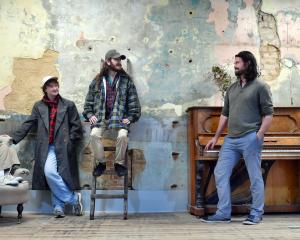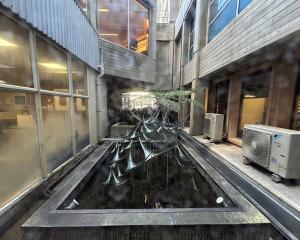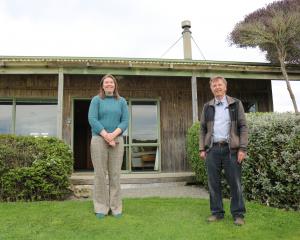
''In the Church Yard'' (First Church grounds)
Anyone wandering past First Church recently will have seen several large-scale sculptures dotting the church grounds.
These eight site-specific pieces have been produced to commemorate the centenary of World War 1.
There is a sombre yet redemptive feel to many of the pieces, appropriate given their subject and location.
The works range from Peter Nicholls' staunch, solid Grit through to Nicola Jackson's sepulchral, a giant urn suggesting funerary rites but covered with images of healing.
Morgan Jones's Dark Harvest is notable, its giant agricultural tools reflecting the ancient Roman fasces, the bundle of sticks used during World War 1 to represent the strength of a unit of men.
Nearby is the hypnotic repetition of Stephen Mulqueen's The Sniper's Prayer with its rifle sights slowly transforming into a Celtic cross.
Philippa Wilson's allegorical tree of life stands nearby, and Bryn Jones's For Ever and Ever, with its connection between the sacrifices of Christ and soldiers, looks across both works.
Salvus, by Pam McKelvey, is rooted in strength and security, its single bluestone boulder held strong against itself by a series of industrial-strength brass bolts.
Perhaps the most compelling of the works is Stuart Griffiths' Poles Apart, its twin sentinels standing with heads bowed as respectful, mournful sentries reflecting on the losses of war.

''Disorder'', Robert Scott (Dead Souls bookshop, Princes St)
I've never been sure how Robert Scott manages to organise his creative talents.
Not satisfied with being a leading member of Dunedin's music scene, a situation which requires frequent touring with the Clean and the Bats, he also has time to produce and exhibit his own distinctive and whimsical artworks.
Scott's art could be loosely considered rustic science fiction, covering rural Otago landscapes and occasional alien envoys.
His acrylic images have an easy, pared-back style which would be well-suited to book illustration and which impress with their strong lines and reassuringly clear colours.
The works, which are generally small and presented on board which is often cut to outline shapes, are appealing in their genial simplicity and warmth.
In a relatively unusual departure for Scott, several of the works have moved to more orthodox rectangular format, and these have been embellished by the deliberate use of bold wooden frames.
Scott's exhibition includes a few works in a new, experimental style for the artist, in which colour has been eschewed, leaving effective and intriguing sketched landscapes on rough board, relieved only by washes of grey paint.
The exhibition is accompanied by a display of historic gig posters from the heyday of the 1980s ''Dunedin Sound'', many of them with artwork designed and drawn by Scott.

''Prism'', Julie Trlin; and "Imbued", Kate Alterio (The Artist's Room)
The Artist's Room is currently presenting twin exhibitions of jewellery by Julie Trlin and Kate Alterio.
The exhibitions complement each other well, striking a balance between the similarities of material and differences of style of the artists.
Neither of the two jewellers produces work which could be called dainty or filigree.
Their work emphasises the power of the stones used, and enhances it by use of strong metallic forms.
In Trlin's work, the stones are left in their natural crystalline state, as suggested by her exhibition's title, the pyramidal and hexagonal prisms of crystal offset by bold metallic casings and chains.
This gives pieces such as the quartz pendant Fire and ice a magical, dramatic quality.
Alterio similarly combines metal and gems, but here the stones have been somewhat tamed, rendered in cabochons and pearl-like spheres.
This allows the metal to assert itself more. Many of Alterio's pieces, such as the onyx Protector earrings, have an Art Deco quality, yet also hark back to far earlier, almost architectural, design.
The titles of the works (Illumination, Transformer, Creator) stress the supposed mystic gifts of gemstones, and when looking at the lambent glow of the moonstone Prophet earrings, it is easy to believe there is truth in those claims.












